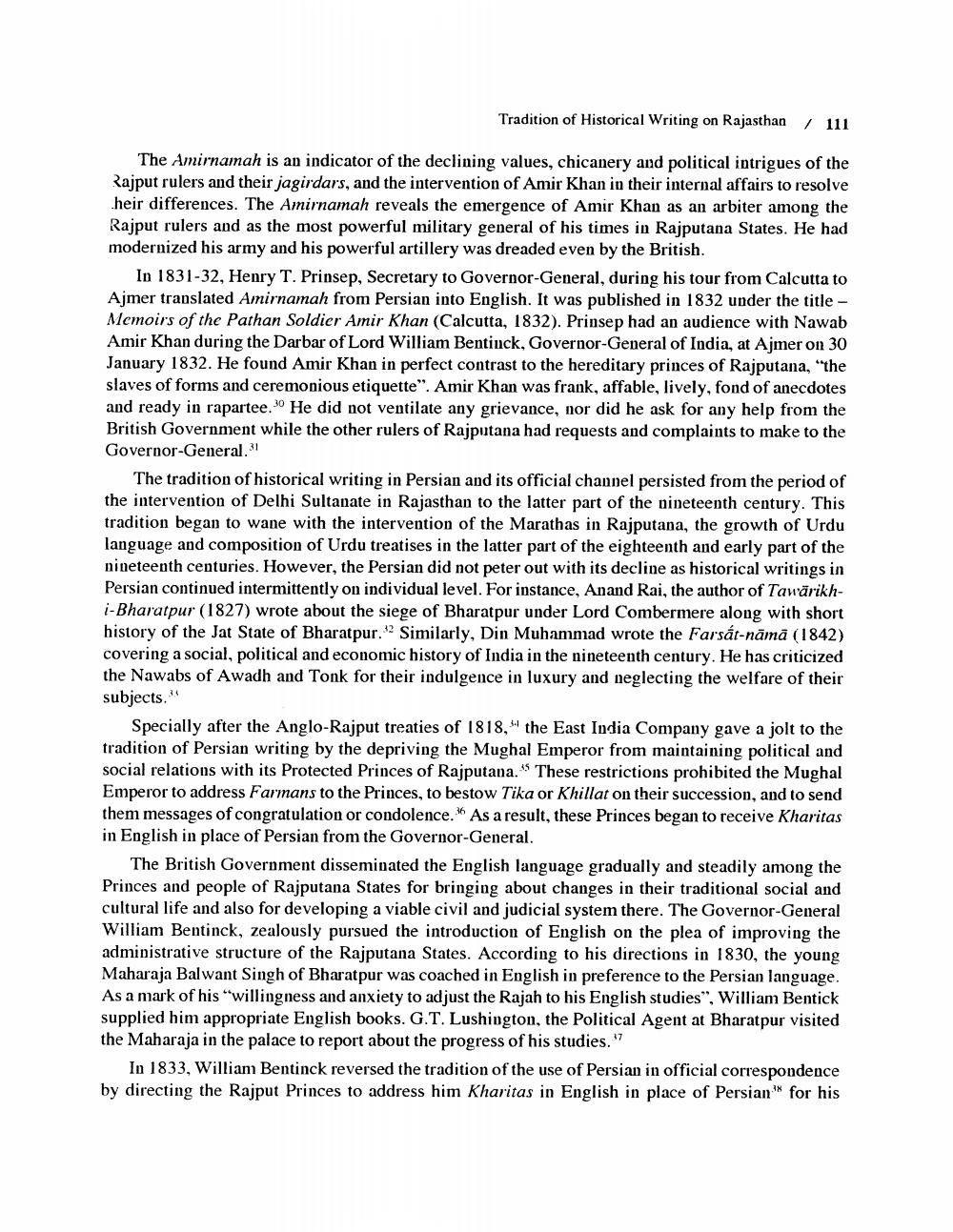________________
Tradition of Historical Writing on Rajasthan
The Amirnamah is an indicator of the declining values, chicanery and political intrigues of the Rajput rulers and their jagirdars, and the intervention of Amir Khan in their internal affairs to resolve .heir differences. The Amirnamah reveals the emergence of Amir Khan as an arbiter among the Rajput rulers and as the most powerful military general of his times in Rajputana States. He had modernized his army and his powerful artillery was dreaded even by the British.
In 1831-32, Henry T. Prinsep, Secretary to Governor-General, during his tour from Calcutta to Ajmer translated Amirnamah from Persian into English. It was published in 1832 under the title - Memoirs of the Pathan Soldier Amir Khan (Calcutta, 1832). Prinsep had an audience with Nawab Amir Khan during the Darbar of Lord William Bentinck, Governor-General of India, at Ajmer on 30 January 1832. He found Amir Khan in perfect contrast to the hereditary princes of Rajputana, "the slaves of forms and ceremonious etiquette". Amir Khan was frank, affable, lively, fond of anecdotes and ready in rapartee. 30 He did not ventilate any grievance, nor did he ask for any help from the British Government while the other rulers of Rajputana had requests and complaints to make to the Governor-General.31
The tradition of historical writing in Persian and its official channel persisted from the period of the intervention of Delhi Sultanate in Rajasthan to the latter part of the nineteenth century. This tradition began to wane with the intervention of the Marathas in Rajputana, the growth of Urdu language and composition of Urdu treatises in the latter part of the eighteenth and early part of the nineteenth centuries. However, the Persian did not peter out with its decline as historical writings in Persian continued intermittently on individual level. For instance, Anand Rai, the author of Tawarikhi-Bharatpur (1827) wrote about the siege of Bharatpur under Lord Combermere along with short history of the Jat State of Bharatpur. Similarly, Din Muhammad wrote the Farsát-nāmā (1842) covering a social, political and economic history of India in the nineteenth century. He has criticized the Nawabs of Awadh and Tonk for their indulgence in luxury and neglecting the welfare of their subjects."
Specially after the Anglo-Rajput treaties of 1818," the East India Company gave a jolt to the tradition of Persian writing by the depriving the Mughal Emperor from maintaining political and social relations with its Protected Princes of Rajputana." These restrictions prohibited the Mughal Emperor to address Farmans to the Princes, to bestow Tika or Khillat on their succession, and to send them messages of congratulation or condolence. As a result, these Princes began to receive Kharitas in English in place of Persian from the Governor-General.
The British Government disseminated the English language gradually and steadily among the Princes and people of Rajputana States for bringing about changes in their traditional social and cultural life and also for developing a viable civil and judicial system there. The Governor-General William Bentinck, zealously pursued the introduction of English on the plea of improving the administrative structure of the Rajputana States. According to his directions in 1830, the young Maharaja Balwant Singh of Bharatpur was coached in English in preference to the Persian language. As a mark of his "willingness and anxiety to adjust the Rajah to his English studies", William Bentick supplied him appropriate English books. G.T. Lushington, the Political Agent at Bharatpur visited the Maharaja in the palace to report about the progress of his studies."
In 1833, William Bentinck reversed the tradition of the use of Persian in official correspondence by directing the Rajput Princes to address him Kharitas in English in place of Persian for his




